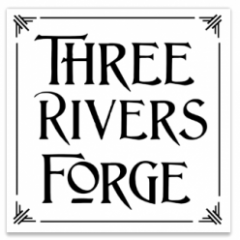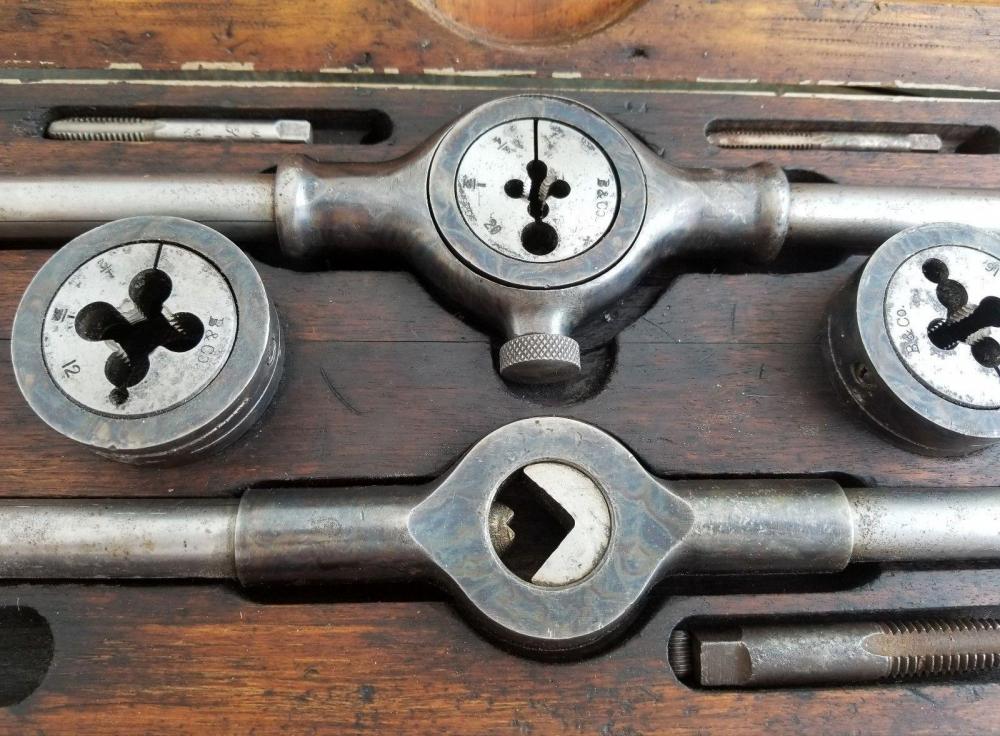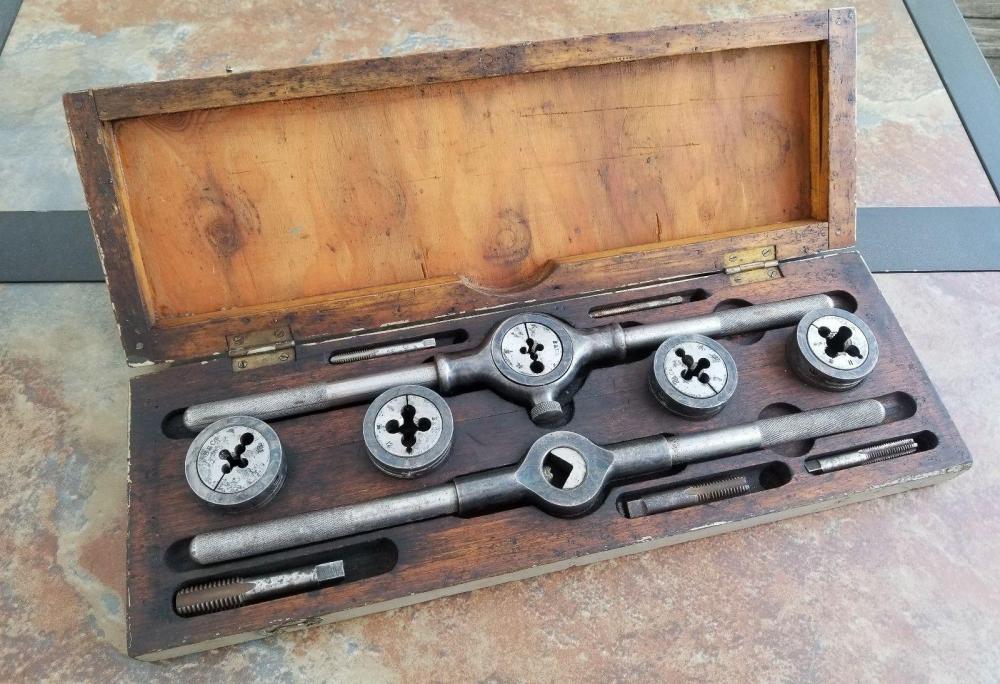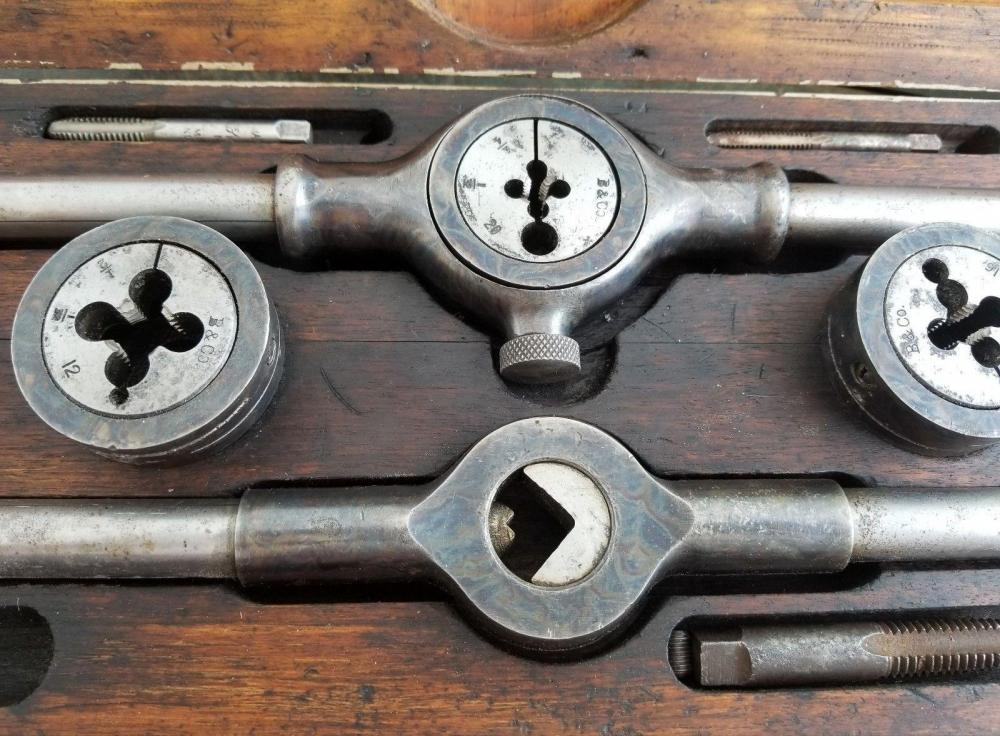-
Posts
3,586 -
Joined
-
Last visited
Content Type
Profiles
Forums
Articles
Gallery
Downloads
Events
Everything posted by VaughnT
-

What do we know about Taps and Dies?
VaughnT replied to VaughnT's topic in Tools, general discussion
Looking around, I found a supplier of taps and dies out of Poland. Most of the stuff I'm finding for a decent price is from china and I really don't like buying from them any more than I have to. I need to get a 1/2-13 set just so I'll have them around if I need them. Almost bought another tap/die set until I saw that it also had the 1/2-12BSW in it. What I might do is buy the round dies that'll fit the stock I already have. Then I can make up a wood box to hold them all pretty like. I won't need many since I don't do a lot of threading. But it's something to feed the addiction! -

What did you do in the shop today?
VaughnT replied to Mark Ling's topic in Blacksmithing, General Discussion
Great job, MC. That post really does your ironwork proud! I just might have to borrow that notion! -

What do we know about Taps and Dies?
VaughnT replied to VaughnT's topic in Tools, general discussion
Amen, Anvil. Amen. I never have understood the preference for the latter when you seem to spend so much time sharpening them only to wear them down to a nub on the very next mark you make. -

What do we know about Taps and Dies?
VaughnT replied to VaughnT's topic in Tools, general discussion
Ain't that the truth. I always wondered why they called them "gun" taps, and now I know. That channel on YT has several nice tutorial movies on various things. The piece on the Verniers and Micrometer was very educational, but a Steel Rule is about as far as I ever need to go in measuring things. I use my steel rule and combination square all the time in the shop. No soapstone or silver pencil for me! How automatic threading heads work! -

What did you do in the shop today?
VaughnT replied to Mark Ling's topic in Blacksmithing, General Discussion
Very nice bit of work! And you're right, no reason to buy something when you can make something of such good quality! That's a hook he'll have for decades into the future, maybe buried in a box somewhere, but you can be sure he'll remember it fondly when he runs across it again! Good job on the plug-welding from the back. The crisp transition is exactly what it called for. The only thing I would have suggested different would have been to drill a 3/4" hole in the base plate and chisel through a few radial lines. Then you could have drifted the hole open larger, driving the "spikes" out much like you see when a rifle round punches through some sheet metal. Insert the tentacle, weld from the back, and then glue on some felt or leather to hide the joint. It would look like the tentacle was breaching through and you'd have a convenient way to hide the joint with a scratch-free surface. Love those suckers on the tentacles. Makes me wish I had a MIG gun instead of the ol' stick-burner! I've tried and tried, but I just can't make that happen with the arc welder. -

What do we know about Taps and Dies?
VaughnT replied to VaughnT's topic in Tools, general discussion
I absolutely love these old-school educational videos. I don't know who they got for narrating all these things, but that guy's voice takes me all the way back! He did a lot of work for a lot of movies back in the day! Greenfield Tap & Die So if you every wanted to know something about taps and dies for threading.... sit back and enjoy twenty-six minutes of glorious 1950's cinematography! -

Signs /Pictures in your shop
VaughnT replied to Jim Coke's topic in Blacksmithing, General Discussion
Ha! What a small world. Gail and Mike, John's family, are good friends and live right across the way. Don't get to see them much anymore, but they're good people. -

Teenage Son Interested in Blacksmithing.
VaughnT replied to AlaskaMom's topic in Blacksmithing, General Discussion
Get a copy of Hasluck's "Bent Ironwork" as a starting point. Don't invest in a lot of tools until he has some time in the trade. Hasluck's book is a great resource because it was designed around projects you can do with minimal tooling and very little metal. He can get his feet wet without breaking the bank, yet turn out some very very nice things for the house if he dedicates himself to it. Everybody wants to make a sword, but nobody wasn't to climb the ladder of experience. Start small and you'll have very little to complain about should he decide to take up playing guitar in a month or three. -
I'd say that's definitely a farrier's vise meant for rasping shoes, not hammering on like a blacksmith's post vise. The sheer doesn't look to be so powerful that I'd want to cut cold steel in it. Maybe good for nipping some hot steel real quick, but it's too lightweight for me to believe it'd cut 1/4" thick bar while cold. The two vise jaws are interesting and would certainly come in handy for a lot of projects outside of farrier work. Replace the missing bolt and you'll have a real dandy for the shop.
-

What did you do in the shop today?
VaughnT replied to Mark Ling's topic in Blacksmithing, General Discussion
Yea, but there's still that caveat "...a design that I like." Gee, thanks, Biggun. -

What did you do in the shop today?
VaughnT replied to Mark Ling's topic in Blacksmithing, General Discussion
This is one of those projects where I wish I'd had a maker's mark. All that bare shank is just begging for a stamp! Sadly, I still haven't come up with a design that I like. -

What did you do in the shop today?
VaughnT replied to Mark Ling's topic in Blacksmithing, General Discussion
Had to do some emergency surgery on my reclining chair. Dang thing broke right at the dogleg in the bar, so you can imagine how fun that was to try and get into position for a simple tack. Looks like the bar was cracked a little, maybe straight from the factory, and the crack just kept growing until critical mass was hit. Finished up another dish before working on the recliner. I love the "night sky" finish on these things. The pebbled texture is nice, but the dark colors really make the whole thing pop, in my estimation. -
Perun is a top-shelf maker of blacksmithing kit. As Marc1 notes, Poland, Hungary, Russia, Estonia.... these places still have a very strong blacksmith presence and the people still appreciate hand-forged ironwork. Perun is a supplier of tooling to this market and wouldn't live long in that environment if they weren't making good stuff that you could rely on. That said, it'd be very expensive to get one over here to the US.
-

What do we know about Taps and Dies?
VaughnT replied to VaughnT's topic in Tools, general discussion
Al, good info! No harm meant with my earlier comments. I appreciate the solid knowledge you're sharing, wood or metal! Got three complete tap sets in the mail the other day. Minty fresh, never used Taper, Plug and Bottom for all three! I'm still hunting for an old-school set of the 1/2-12BSW, but there's no hurry. The hunt is half the fun -- even if it's for something I'll probably never use! Already got a small project in mind that'll require my 3/8-16 tap and die. Not sure it'll work, but I'm sure it'll be fun to try. -
I would love to have a few dozen of those big springs. Right off the bat, they make great stools! Seriously, folks love those heavy industrial springs for stools. They're rigid, they look cool, they have some heft to them.... Figure out way to mount a nice seat and you could sell them pretty quickly to boutique interior decorator types. For me, I'd use one for in the shop just so I'd have a nice place to sit and take a break. I'd do a test piece to see what kind of quench medium they like. If you can get them for free.... they'd be great for smaller hammers if you like making those kinds of things. Of course, it's all about being able to heat-treat them properly so they'll perform like you want. They might be a water-quench steel since they're mass-produced and a lot of companies are going that route because it's easier to clean up. Hard to say, though. Definitely think about bar stools and foot rests. Furniture that has an "industrial" look is pretty popular and demands a very high price.
-

What do we know about Taps and Dies?
VaughnT replied to VaughnT's topic in Tools, general discussion
It is supposed to be about taps and dies -- hence the title of the thread. The funny part is that a moderator just hit me with a "demerit" for spamming, yet here are all these people spamming away, cluttering up a thread with nonsensical comments that have absolutely nothing to do with the subject matter being discussed. This is the kind of stuff that makes the search function here even less functional. Since you all want to talk about woodworking on an ironworking forum, let's at least try to keep it within the of the subject being discussed in the thread. Here's a very nice video on making wooden threads -- with information I'd never heard before. Love the bubbles! https://www.youtube.com/watch?v=nbY6El9Pzcs If you want to talk about tenons in wood furniture, please feel free to do so in another thread. If you're curious about how far back in time someone's magazine collection goes... again, feel free to start a line of discussion around magazine subscriptions. -

What did you do in the shop today?
VaughnT replied to Mark Ling's topic in Blacksmithing, General Discussion
Another rosette finished. I wasn't sure where I was going with this, so I decided to keep it simple. Just 2" square, they're a great size for a whole slew of projects! The blanks are better than an 1/8" thick I'm sure. Maybe .130" -- I forgot to measure them when I was in the shop. The nice thing about all that metal is that you can really work it to create a lot of depth to the pieces. -

What did you do in the shop today?
VaughnT replied to Mark Ling's topic in Blacksmithing, General Discussion
I've had the world's worst luck with acquiring a fly press. Twice someone has said they had one they'd part with for a decent price... and then they simply stop communicating. Even went so far as to email with a company in England that sells used fly presses and has that right in the name of their website. A few emails back and forth... and then nothing. I'm looking to spend two grand with the guy, and he just drops off the radar. One might almost think I'm being given a sign from above! -

Show me your Bottle Openers!
VaughnT replied to Arbalist's topic in Blacksmithing, General Discussion
Very nice work, Grumpy. Looking at those openers, my very first thought was that they looked like neck ties. It was only all this talk about weapons that made me see them as possible blades, and even then my first reaction was "Cool, those would be great Kiradashi for woodworkers!" Either way you cut it, that's some nice work and you could market them to cabinet makers or businessmen. -

What did you do in the shop today?
VaughnT replied to Mark Ling's topic in Blacksmithing, General Discussion
Oooh, how I wish I had a fly press! That will hopefully happen early next year. Until then.... -

What did you do in the shop today?
VaughnT replied to Mark Ling's topic in Blacksmithing, General Discussion
Thank you. Found some pics of the blanks as they come from Rich. Very neat and clean, and perfectly matched to the next. Thank you. I had thought to just use the chased lines as guides for making deeper lines when the part was hot, but thought I'd keep this one as simple as possible. Doing the chasing while cold makes it a lot easier to handle things, placing the lines exactly where I want them without worrying about double-stamping, missing the mark, etc. I found that chasing a deep groove at the base of the little leaf made them a lot easier to bend when hot, and made the overall curl far more natural because you didn't have a flat start in things. I was almost worried I might snap them off if I worked them to a black heat, so I kept things nice and toasty! -

What did you do in the shop today?
VaughnT replied to Mark Ling's topic in Blacksmithing, General Discussion
Thank you. I had these cut for me by Rich Baker over at Plank-n-Ingot. As I understand it, they're plasma cut. I tried to cut some out by hand, but it was so time-consuming! I'd have had to charge $200 for each rosette, and I'd likely have gone insane before I was done with the second one! :O Thank you. They're very fun to make. -
You can most definitely buy brand new A33, flutagon, today. Brent Bailey uses it regularly and just posted a video on youtube where he gives the contact info for a guy selling it by the foot for folks that want to try it, but can't afford a full stick of it. My score for the day..... a gorgeous vintage tap-n-die set. Just look at that magnificent color case hardening! How could you not want something like this in your life? That 1/2-12 die isn't a misprint. That's a very old thread style called the British Whitworth Standard (BSW) and is claimed to be the first standardized thread type. The set is missing one key set screw that I hope to replace soon. And then I have to start hunting down sets of taps to go with them. While I have the taper taps for all of them, I'd really like to get the plug and bottom taps to complete things. I'll likely never ever need them, but sure as not, I'll have something come up where they'll be needed if I don't have them on hand!
-

What did you do in the shop today?
VaughnT replied to Mark Ling's topic in Blacksmithing, General Discussion
-

What do we know about Taps and Dies?
VaughnT replied to VaughnT's topic in Tools, general discussion
Thank you for the very kind words, horse. Compare this beautiful machining and color case hardening to what is produced today...... And, honestly, you can get vintage gear for as cheap or cheaper than you can buy new stuff. When I was looking, I found plenty of brand new sets in garish plastic cases, undoubtedly made in some factory overseas. They often had a larger selection of taps and dies in the kits, but they also had a complete lack of soul. They looked cheap and chintzy, especially in those ugly injection-molded cases. I wish you well on your journey down this particular rabbit hole. How do you tell which dies are for chasing and which are for cutting new? If it's not the outer perimeter style, what then gives it away? How do you use the tapered taps to "make multiple size threads"?? I'm missing something there. If you drill the hole to the size proper for the thread you need, what's the benefit of a tapered tap? Even in a punched hole, there's only so much you can do because the threaded hole will always end up with an hourglass cross-section. As such, I'd think it's a pretty weak joint since the bolt is only hanging on a very thin thread right at the waist of the hourglass.




